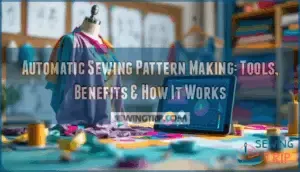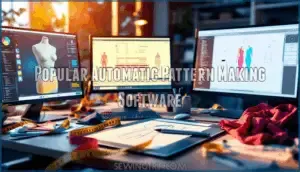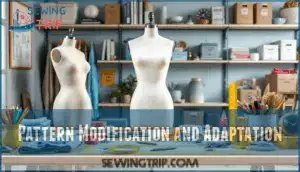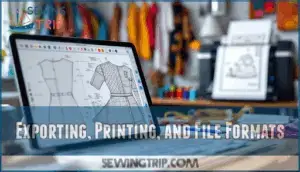This site is supported by our readers. We may earn a commission, at no cost to you, if you purchase through links.
 Right now, 38% of online clothing returns happen because of fit issues—a problem that costs retailers billions and leaves sewers frustrated with patterns that miss the mark. Automatic sewing pattern making changes this equation by generating patterns from your exact measurements, whether you’re working with body scan data or a simple tape measure.
Right now, 38% of online clothing returns happen because of fit issues—a problem that costs retailers billions and leaves sewers frustrated with patterns that miss the mark. Automatic sewing pattern making changes this equation by generating patterns from your exact measurements, whether you’re working with body scan data or a simple tape measure.
The software does the math and drafting work, translating dimensions into pattern pieces that account for your unique proportions. Instead of choosing between standard sizes that rarely fit perfectly, you get patterns built around your body from the start.
This shift toward measurement-driven design opens up possibilities for better garments, less fabric waste, and projects that actually turn out the way you imagined.
Table Of Contents
- Key Takeaways
- What is Automatic Sewing Pattern Making?
- Key Benefits of Digital Pattern Drafting
- Popular Automatic Pattern Making Software
- Essential Features of Pattern Making Tools
- Choosing The Right Software for Your Needs
- Industry Applications and Future Trends
- Frequently Asked Questions (FAQs)
- Conclusion
Key Takeaways
- Automatic sewing pattern making generates custom patterns from your exact measurements using software algorithms, eliminating the need to squeeze into standard sizes that rarely fit—this precision reduces online clothing return rates from 30% down to just 7% for made-to-measure garments.
- Digital pattern drafting cuts textile waste by up to 20% through optimized fabric layouts and reduces prototyping time by 70%, transforming pattern creation from a days-long manual process into a matter of minutes while supporting sustainable fashion practices.
- Free open-source tools like FreeSewing, Seamly2D, and Valentina deliver professional-grade parametric design without licensing fees, making custom pattern creation accessible to anyone with internet access, while industrial software like Gerber AccuMark handles mass production requirements.
- The technology integrates AI-generated patterns, 3D body scanning, and laser cutting into unified workflows that achieve 95% wearability for basic garments and enable cloud-based collaboration where pattern makers share, modify, and refine designs in real-time across global communities.
What is Automatic Sewing Pattern Making?
Automatic sewing pattern making transforms the way you create garments by using software to generate patterns based on your exact measurements. Instead of adjusting standard sizes or drafting patterns by hand, you input body dimensions and let the system calculate the shapes you need.
This approach opens up new possibilities for fit, customization, and efficiency in your sewing projects.
How Automatic Pattern Generation Works
Ever wonder how software can take a handful of measurements and spin them into a perfectly drafted pattern in seconds? It’s all about parametric design and measurement-driven algorithms. You input your dimensions, and the digitalization process runs those numbers through built-in formulas that automatically generate pattern pieces customized to your body.
This automatic pattern generation manages digital pattern drafting and pattern adjustments in real-time, though automation limits mean you’ll still need to review fit and make tweaks for truly unique shapes.
Custom Measurements and Made-to-Measure Fit
Those measurements you enter aren’t just numbers—they’re the foundation of made-to-measure patterns that transform fit satisfaction. Measurement accuracy for bust, waist, and hip circumferences matters because custom fit patterns cut return rates dramatically (fit issues cause 38% of online apparel returns). Here’s why exact measurements yield better garments:
- Body inclusivity: Coverage for 99% of body types, far beyond standard sizing
- Return reduction: Only 7% of custom garments come back versus 30% for off-the-rack
- Online growth: Made-to-measure market jumped from $8.1B in 2023 to a projected $17.2B by 2032
- Premium performance: Satisfaction scores run 15-25% higher than standard sizing options
The increasing consumer demand drives this market’s expansion.
Parametric Design Vs. Standard Sizing
Standard sizing forces your body into predetermined boxes, but parametric design flips that script by building patterns around you. Instead of guessing between a 10 and 12, you input your actual measurements for design precision that conforms to body diversity. Size inclusivity becomes reality when software recalculates every dart and seam for fit consistency.
| Aspect | Standard Sizing | Parametric Design |
|---|---|---|
| Approach | Fixed size charts | Made-to-measure patterns with measurement accuracy |
| Fit | Approximate | Precise pattern customization |
| Range | Limited sizes | Unlimited customization benefits |
Key Benefits of Digital Pattern Drafting
Digital pattern drafting isn’t just about convenience—it’s about unlocking precision, sustainability, and efficiency that manual methods can’t match. Whether you’re cutting costs, reducing waste, or simply getting a better fit, the advantages add up fast.
Let’s break down the three main benefits that make automatic pattern making worth your attention.
Improved Fit and Consistency
When your handmade garment fits like it was custom-made just for you, that’s not luck—it’s the precision of parametric design at work. Body scan integration and measurement accuracy transform custom fit patterns into garments that hug your curves exactly right.
Here’s what you gain:
- Fit personalization conforms to your unique measurements
- Automated grading scales patterns without losing proportions
- Garment prototyping tests fit before cutting fabric
- Pattern customization eliminates sizing frustrations
Pattern modification becomes simple, and garment fitting issues practically disappear.
Reduced Textile Waste and Sustainability
Precision in digital pattern drafting isn’t just about fit—it’s a quiet revolution in sustainable fashion. AI Fabric Cutting slashes textile waste by up to 20%, while Zero-Waste Design techniques eliminate cutting waste entirely in some prototypes. Digital Prototype Reduction means fewer physical samples, cutting fabric and dye waste per collection.
Digital pattern drafting is a quiet revolution in sustainable fashion, slashing textile waste by up to 20% through AI-driven precision
Pre-Consumer Recycling becomes more viable as AI optimizes scrap recovery, and Carbon Footprint Calculation tools track environmental impact across your garment’s lifecycle, supporting eco-friendly practices and sustainable fabrics in the slow fashion movement.
AI can further assist by optimizing textile production to reduce environmental degradation.
Time and Labor Savings in Pattern Creation
Speed transforms the entire pattern-making game—what once consumed days of manual drafting now happens in minutes with a few clicks. Automation efficiency streamlines the digital workflow, enabling faster iteration and reduced prototyping cycles.
Pattern making software addresses the pattern generation process instantly, while real-time pattern customization lets you tweak designs on the fly.
This translates directly to cost reduction—fewer labor hours, less material waste, and quicker turnaround from concept to finished garment.
Popular Automatic Pattern Making Software
When you’re shopping for automatic pattern-making software, you’ll find options that range from completely free to professional-grade investments. The good news is that you don’t need deep pockets to get started—some of the best tools won’t cost you a dime.
Let’s break down your choices into three main categories so you can find the right fit for your skill level and budget.
Free and Open Source Options (FreeSewing, Seamly2D, Valentina)
You don’t need deep pockets to access powerful pattern-making software. FreeSewing, Seamly2D, and Valentina are open-source tools offering parametric design and community support without licensing fees.
FreeSewing has over 179,700 users generating custom patterns online, while Seamly2D and Valentina provide professional-grade CAD functions across Windows, macOS, and Linux.
These platforms deliver user accessibility with substantial customization options, making made-to-measure pattern creation available to anyone with internet access.
Professional Tools (Gerber AccuMark, CAD Software)
When you’re scaling up production or need millimeter-perfect precision across thousands of garments, professional CAD software like Gerber AccuMark becomes the industry workhorse.
AccuMark Automation tackles grading, marker making, and complex stitching patterns that meet industry standards.
The CAD investment is steep—often requiring computational power and training—but it delivers the repeatable accuracy fashion manufacturers depend on when consistency isn’t negotiable.
Apps for Mobile Pattern Design
Pattern design has jumped straight into your pocket—mobile apps now let you draft, adjust, and even print sewing patterns without ever touching a desktop computer.
Digital sewing platforms offer cloud integration for accessing your designs anywhere, while some apps explore AR integration to visualize patterns on fabric.
These online tools bring pattern digitization and mobile CAD accessibility to sewists who want flexibility without sacrificing precision.
Essential Features of Pattern Making Tools
The best pattern making software won’t do you much good if it can’t process the basics—or your specific project needs. Before you commit to any tool, you’ll want to make sure it covers three core capabilities.
Here’s what separates a useful program from one that’ll just frustrate you.
Real-Time Customization and Grading
Imagine tweaking a collar width or sleeve length and watching the entire garment pattern recalculate itself in seconds—that’s the magic of real-time customization and grading. This flexible pattern adjustment relies on individual fit algorithms that respond to instant measurement input.
When you enter your dimensions, adaptable design systems update every connected seam and curve automatically. Automated size grading lets you scale patterns across multiple sizes without starting from scratch, turning design iteration into a fast, fluid process.
Pattern Modification and Adaptation
Once your pattern fits like a dream, you’ll want to tweak it—maybe add a pocket here, lengthen a hem there, or merge design elements from two different garments. Pattern modification and adaptation tools let you experiment without redrawing everything.
Most software accommodates common pattern alterations like:
- Fit adjustments (dart placement, neckline depth)
- Style changes (sleeve shape, collar type)
- Pattern hacking (combining patterns for unique designs)
These sewing techniques transform basic templates into individual creations, making pattern customization accessible even if you’re new to pattern design and customization.
Exporting, Printing, and File Formats
After you’ve fine-tuned your pattern to excellence, getting it off your screen and onto fabric is the final hurdle—and choosing the right file format can make or break your cutting day. Most pattern-making software exports to PDF for home printing or DXF for commercial printing and plotter compatibility.
Understanding export settings helps you scale patterns accurately, maintain digital storage efficiency, and guarantee file compatibility across different systems.
| Format | Best For |
|---|---|
| Home printing, easy sharing | |
| DXF/DWG | Plotter compatibility, commercial cutting |
| SVG | Digital pattern formats, scaling flexibility |
Choosing The Right Software for Your Needs
Picking the right pattern software depends on your skill level, budget, and the types of garments you want to create. Beginners need different tools than professionals, and designing for children or plus-size bodies comes with unique challenges.
Let’s break down your options so you can find the perfect fit.
Beginner-Friendly Software Options
If you’re just starting out, you’ll want software that doesn’t throw a mountain of confusing buttons and cryptic menus at you before you’ve even drafted your first bodice.
Look for beginner-friendly software like FreeSewing or Seamly2D that offers simple features, free tutorials, and strong community support to help you quick start your pattern making journey with digital patterns that actually make sense.
Advanced Features for Professionals
As you level up past the basics, you’ll need tools that can process complex grading algorithms, multi-size nested markers, and industry-standard file exports that production teams actually want to receive.
Professional pattern making software like Gerber AccuMark delivers 3D garment simulation, automation scripting for repetitive tasks, and production-ready patterns with data analytics built right in.
CAD integration and custom algorithms let you fine-tune grading tools to match your exact specs.
Considerations for Children’s and Plus-Size Patterns
Not every body fits the same formula—children grow in unpredictable spurts, and plus-size frames often need different curve placements and proportional adjustments that standard grading just can’t manage.
Look for software that lets you make growth adjustments and proportional scaling tweaks, with built-in ease allowances that shift based on fabric considerations. The best tools offer style adaptations specifically designed for plus-size fitting and children’s sizing challenges.
Industry Applications and Future Trends
Automatic sewing patterns aren’t just for home hobbyists anymore—they’re transforming how the fashion industry designs, produces, and shares clothing at every scale. From factory floors running hundreds of garments per hour to designers collaborating across continents, digital pattern-making is reshaping what’s possible.
Let’s look at where this technology is making the biggest impact and where it’s headed next.
Apparel Manufacturing and Mass Production
When you’re making hundreds—or thousands—of the same garment, consistency isn’t just nice to have; it’s the whole ballgame. Automation benefits clothing manufacturers by streamlining pattern grading and marker making, which keeps quality control tight across production runs.
Industry standard sizing becomes achievable at scale, and cost optimization happens when production-ready patterns feed directly into supply chains without human error slowing things down.
AI, 3D Scanning, and Laser Cutting Integration
You’re stepping into the future when AI tools, 3D design, and laser cutting converge into fluid workflows. Automated grading and digital prototyping slash development time by up to 70%, while smart factories use real-time data to refine every stitch.
- AI-generated patterns reach 95% wearability for basic garments
- 3D body scans capture measurements in seconds for custom fit
- Laser cutting adjusts automatically for fabric type and thickness
- Digital pattern making reduces textile waste through optimized layouts
- Fashion design applications integrate scanning, AI, and cutting for resource optimization
Cloud Collaboration and Community Sharing
Imagine uploading your pattern to a shared library at midnight and waking up to three fresh modifications, two fit reviews, and a video tutorial—all before breakfast. Cloud storage turns pattern-sharing communities into real-time workshops where template sharing, version control, and community feedback spark constant innovation.
Sewing forums and pattern-sharing groups boost open-source benefits—you’ll learn faster when sewist social networks and forums merge community engagement with practical pattern refinement.
Frequently Asked Questions (FAQs)
Can I use automatic patterns for historical costumes?
Automatic pattern-making tools excel at period-accurate patterns through pattern customization and pattern modification features. You’ll input historical measurements for custom-fit designs and made-to-measure garments, then adjust for fabric considerations like brocade or muslin.
Pattern scaling accommodates embellishment adaptations, while garment construction techniques respect historical seaming and weaving methods authentically.
How do pattern makers handle stretch fabrics digitally?
Digital pattern design tools tackle stretch by measuring fabric recovery and programming that behavior into patterns. Parametric garment construction adjusts for knit distortion using tension mapping and stretch compensation algorithms.
Fabric simulation in sewing patterns creation mimics how material moves before you cut.
What file formats work best for commercial printing?
PDF and DXF formats dominate commercial printing because they preserve vector drawing software accuracy and manage multisize files reliably.
Production-ready patterns need vector (not raster) files, proper resolution requirements, accurate color profiles, and bleed margins to guarantee format compatibility.
Are automatic patterns compatible with industrial sewing machines?
Yes, automatic patterns work with industrial machines when exported in production-ready formats like DXF or AECAD. Industry standard pattern grading tools and marker making capabilities guarantee garment construction meets automation integration requirements, though material thickness limits and stitch type limitations vary by equipment.
How accurate are body measurements from smartphone photos?
A picture tells a thousand words—but not always exact measurements. Smartphone photo-based body scanning shows moderate accuracy for bust, waist, and hip circumferences, but struggles with vertical dimensions and cross measurements.
AI measurement bias and mobile app reliability vary widely. For clothing fit prediction matching your unique body shape, apps work best as estimates, not replacements for precise tape measurements.
Conclusion
Think of your measurements as coordinates on a map—once plotted correctly, they guide you straight to garments that fit. Automatic sewing pattern making removes the guesswork from this journey, turning numbers into wearable pieces that honor your body’s reality instead of forcing you into someone else’s standard.
Whether you’re a hobbyist cutting fabric at your kitchen table or a designer scaling production, these tools shift the power back to precision. You’ll spend less time ripping seams and more time creating clothes that actually work. That’s not just efficiency—it’s creative freedom.
- https://growthmarketreports.com/report/automatic-pattern-sewing-system-market
- https://dataintelo.com/report/automated-sewing-machine-market
- https://www.linkedin.com/pulse/programmable-pattern-sewing-machine-market-industry-trends-forecast-period-35dof
- https://straitsresearch.com/report/industrial-sewing-machine-market/united-states
- https://thesai.org/Downloads/Volume16No2/Paper_29-Integrating_Artificial_Intelligence_to_Automate_Pattern.pdf













